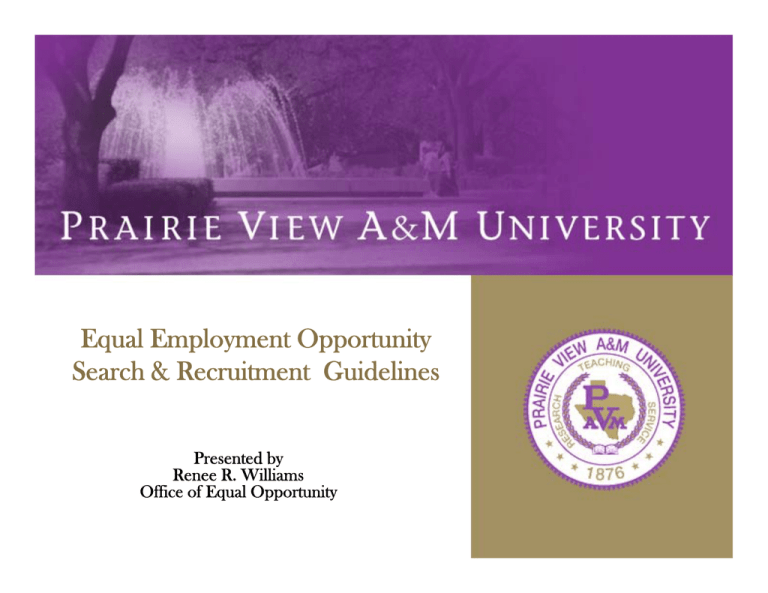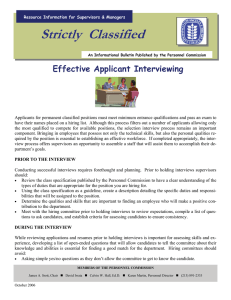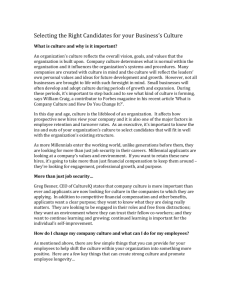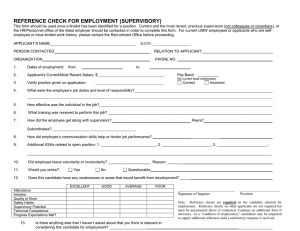Equal Employment Opportunity Search & Recruitment Guidelines Presented by Renee R. Williams
advertisement

Equal Employment Opportunity Search & Recruitment Guidelines Presented by Renee R. Williams Office of Equal Opportunity Office Mission o To promote and provide a discrimination free workplace, learning and living environment, where every employee, student, applicant and visitor knows that he or she is valued as an individual and is treated with respect and dignity; free of discrimination and harassment based upon an individuals’ race, color, gender, religion, age, national origin, disability and veteran’s status. What is Equal Employment Opportunity? The right of ALL persons to be considered based on their ability to meet the requirements of the job. Because equal opportunity does not typically change existing conditions, affirmative action efforts may be necessary What is Affirmative Action? Refers to (efforts) made to expand employment opportunity for members of a particular race, gender, ethnicity, or other group (previously) excluded from employment opportunities. These efforts must be consistent with applicable laws & regulations. What is Underrepresentation? Occurs when the percentage of employees in a protected group (women or minorities) is less than the availability percentage for that protected group, as indicated by census data, reports of graduates from graduate programs, and other data that give an indication of how many individuals in the protected class are available in the geographic recruiting area. This term is used by affirmative action planers who seek to apply good faith efforts to increase the percentage of utilization of minorities and women in the work force. Documenting Fair Screening & Selection It is important to ensure (fairness) to ALL applicants during the screening and selective process. Fairness has been achieved if the following criteria exists: – Consistent treatment of applications at each stage of the selection process – Consistent evaluation of all applicants – Stated qualifications providing the basis for the selection criteria used in the final decision – Documented process & decisions Developing Preset Selection Criteria The selection criteria must be: • Carefully defined • Related to the requirements of the position • Clearly understood and accepted by the members of the search committee The ability of the candidate to add intellectual diversity and cultural richness to the department should be included among the selection criteria. Evaluating the Applicant Pool • The search committee evaluates the applicant pool by screening applications based on advertised minimum and preferred qualifications & experience • The committee is cautioned to be mindful of biases in the screening process that could inadvertently screen out wellqualified applicants with non-tradition career paths, nontraditional research interests or publications • It is important to know that diverse paths and experiences can make positive contributions to a candidate’s qualifications. Selecting Candidates to Interview • • • • • • • • The search committee identifies candidates who will be considered further for the position based on the position requirements, candidate’s qualifications and experience, diversity objectives and application evaluation scores and forwards the following to the OEO for review and approval: Standard Hiring Evaluation Matrix complete with application evaluation scores for each applicant; (Applicant’s Skills Score) Standard Interview Questions Matrix complete with proposed interview questions; Request to Interview form listing applicants for interview. Copies of ALL applications received List of ALL applicants (from PV-PAWS); Copy of Job Description posted. Tips on Identifying the Best-Qualified Candidate (Sample Questions) Does the candidate: • Satisfy advertised requirements for the position? • Have the skills to perform the essential functions for this position? • Demonstrate the potential to be successful in the promotion and tenure review? • Have teaching experience with diverse populations? • Have scholarly expertise related to diversity in the discipline? Tips on Identifying the Best-Qualified Candidate (Sample Questions) cont. Does the candidate: • Add intellectual diversity to the college community? • Bring interesting life experiences that will benefit diverse students? • Enlarge cultural richness within the college community? • Demonstrate special talents and knowledge needed to serve as a mentor/role model for students in underrepresented groups? • Alleviate underrepresentation in a discipline or within the college? After the Interview • The search committee completes and scores Standard Interview Questions Matrices. • Final total interview scores are placed on Standard Hiring Evaluation Matrix for each applicant interviewed. (Interview Score) • Reference check telephone calls are placed for finalists that will be recommended to the hiring official. The reference checks are conducted and documented either by the Search Committee Chair or the Hiring Official. (Job Reference Score) • Final reference scores are placed on the Standard Evaluation Hiring Matrix and totals are tallied across the form for all applicants to derive a final (Applicant Aggregiate Score) Completing the Search Process • Final recommendations are submitted to Hiring Official • Submission to OEO all completed: - Hiring Evaluation Matrix (application review scores, interview scores, reference scores, and any justification for nonselection interviewees) - Interview Questionnaires (all committee members) - Evaluation Notes by S/C members Hiring Proposal Process • Contact the Office of Human Resources prior to making any offers of employment: • Ms. Jana Smith 936-261-1730 jbsmith@pvamu.edu Office of Equal Opportunity Renee R. Williams Equal Opportunity Compliance Officer Office of Student Affairs & Institutional Advancement A. I. Thomas Bldg., Suite 013 936-261-2123 936-261-2139 (fax) rrwilliams@pvamu.edu (Email) http://www.pvamu.edu/pages/929.asp (Website)





